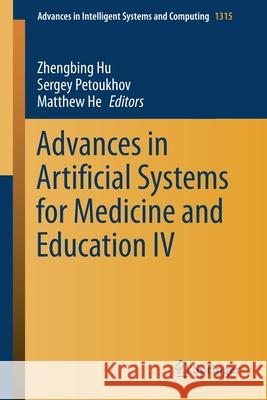Advances in Artificial Systems for Medicine and Education IV » książka



Advances in Artificial Systems for Medicine and Education IV
ISBN-13: 9783030671327 / Angielski / Miękka / 2021 / 410 str.
Advances in Artificial Systems for Medicine and Education IV
ISBN-13: 9783030671327 / Angielski / Miękka / 2021 / 410 str.
(netto: 576,41 VAT: 5%)
Najniższa cena z 30 dni: 578,30
ok. 22 dni roboczych
Bez gwarancji dostawy przed świętami
Darmowa dostawa!
Advances in Mathematics and Bio-mathematics
Functional Systems Integrated with a Universal Agent of Artificial Intelligence and Higher Neurocategories
Georgy K. Tolokonnikov, admcit@mail.ru
Genetic Interpretation of Neurosemantics and Kinetic Approach for Studying Complex Nets: Theory and Experiments
Ivan V. Stepanyan, neurocomp.pro@gmail.com
Focal Curves in the Problem of Representing Smooth Geometric Shapes
Rakcheeva T., rta_ra@list.ru
Method of Fuzzy Agreed Alternative Selection in Multi-agent Systems
N.Yu. Mutovkina, letter-boxNM@yandex.ru
Evaluation of the Effect of Preprocessing Data on Network Traffic Classifier based on ML Methods for Qos Predication in Real-time
Irina A. Krasnova, angel@mail.ru
The Task of Improving the University Ranking Based on the Statistical Analysis Methods
Mikryukov, Mikrukov.aa@rea.ru
Deep-learned Artificial Intelligence for Consciousness – Thinking Objectization to Rationalize a Person
Nicolay Vasilyev, nik8519@yandex.ru
Algorithmization of Computational Experiment Planning based on Sobol Sequences in the Tasks of Dynamic Systems Research
G.I. Firsov, firsovgi@mail.ru
Modification of the Hausdorff Metric in Combination with the Nearest Point Algorithm ICP in Point Cloud Construction Problems
Vladimir M. Shardakov, werovulv@inbox.ru
Calculation of the Current Distribution Function over a Radiating Structure with a Chiral Substrate Using Hypersingular Integral Equations
Alexander A. Potapov, potapov@cplire.ru
Influence of Image Pre-processing Algorithms on Segmentation Results by Method of Persistence Homology
Semyon Romanov, cwwc@bk.ru
Influence of Delays on Self-oscillations in System with Limited Power-supply
Alishir A. Alifov, a.alifov@yandex.ru
Cognitive Prediction Model of University Activity
Mikryukov, Mikrukov.aa@rea.ru
Advances in Medical Approaches
Temperature Reaction of a Person with a Contact Method of Exposure to a Thermal Signal
A. A. Shul' zhenko, aa_shulzhenko.01@mail.ru
Study of the Force-moment Sensing System of a Manipulative Robot in Contact Situations with Tenzoalgometry of Soft Biological Tissues
Maksim V. Arkhipov, maksim_av@mail.ru
The Influence of Hydroplasma on the Proliferative and Secretory Activity of Human Mesenchymal Stromal Cells
P.S. Eremin, ereminps@gmail.com
The Biotechnological Method for Constructing Acoustic and Vibration Sequences based on Genetic DNA Sequences
Sergey V. Petoukhov, spetoukhov@gmail.com
Modelling of Piezoelectric Disk Transducers Operated on Non-axisymmetric Oscillations for Biomedical Devices
Constantine Bazilo, b_constantine@ukr.net
Inherited Bio-symmetries and Algebraic Harmony in Genomes of Higher and Lower Organisms
Sergey V. Petoukhov, spetoukhov@gmail.com
Telemedicine Monitoring with Artificial Intelligence Elements
Nikita E. Shklovskiy-Kordi, nikitashk@gmail.com
Modeling of the Cognitive Properties of the Brain Thalamus as a System with Self-organized Criticality
M.E. Mazurov, mazurov37@mail.ru
Advances in Technological and Educational Approaches
The Natural Intelligence of the Wind Castle Design with the World Natural Heritage of Jeju Island
Jeong Su Kim, kjs@mail.kcu.ac
The Impact of Interactive Visualization on Trade-Off-Based Decision-making Using Genetic Algorithm: A Case Study
Bui V. Phuong, phuongbv1991@gmail.com
Advantages of Fuzzy Controllers in Control of Technological Objects with a Big Delay
Ruslan Bazhenov, r-i-bazhenov@yandex.ru
Synthesis of l-coordinate Parallel Mechanism without Singularities
Gagik Rashoyan, gagik_r@bk.ru,
SWOT Analysis of Computer Distance Learning Systems
N.Yu. Mutovkina, letter-boxNM@yandex.ru
Research on Student Achievement Prediction based on BP Neural Network Method
Deng Pan, 475388483@qq.com
Post-quantum Digital Signature Scheme for Personal Data Security in Communication Network Systems
Sergiy Gnatyuk, s.gnatyuk@nau.edu.ua
A Motor Fault Detection Method based on Optimized Extreme Learning Machine
Jun Su, yanlingyu@hbut.edu.cn
Multi-fidelity Multicriteria Optimization of Strain Gauge Force Sensors Using a Neural Network-Based Surrogate Model
Sergey I. Gavrilenkov, gavrilenkovsergei@bmstu.ru
Traffic Intelligent Control at Multi-section Crossroads of the Road Networks
Andrey M. Valuev, valuev.online@gmail.com
On the Efficiency of Machine Learning Algorithms for Imputation in Spatiotemporal Meteorological Data
Andrey K. Gorshenin, agorshenin@frccsc.ru
Virtual Simulation Experiment Scheme for Software Development Courses based on Situational Teaching
Qizhi Qiu, qqz@whut.edu.cn
Evaluation Model of Sports Media Talent Training System in the New Media Era
Ziye Wang, kathy8899@1com
Network Module of Generative Adversarial Network for Low-light Image Enhancement
Yan Lingyu, yanlingyu@hbut.edu.cn
Research on the Influence of Rules of Ships Entering and Leaving Port on Waiting Time of Large and Small Ships
Ping Zhong, 1045007790@qq.com
A Neural Network Featured System for Learning Performance of Students
Deng Pan, 475388483@qq.com1997-2025 DolnySlask.com Agencja Internetowa
KrainaKsiazek.PL - Księgarnia Internetowa









